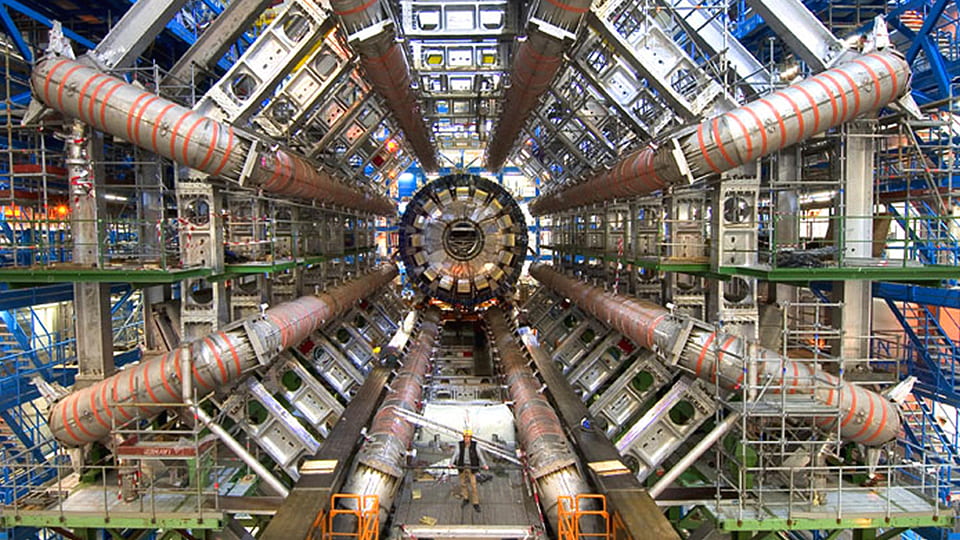Crash course in physics
As revamped Large Hadron Collider fires up to record levels, UCI team prepares to pick through pieces of shattered particles

The world’s biggest particle smasher – in fact, the world’s biggest machine – is warming up for its next performance: hitting record-high power in a bid to unlock the secrets of the universe.
And a team of UC Irvine researchers will likely play a key role in any future discoveries.
The Large Hadron Collider, a 17-mile ring buried beneath the countryside on the Swiss-French border, made history in 2012 by capturing evidence of the Higgs boson. It was the last exotic beast sought by scientists to complete a menagerie of particles predicted by the standard model of particle physics.
But that was only at about half the power the LHC – after two years of repairs and upgrades – is expected to reach in the months ahead. The massive collider ring, made up of superconducting magnets studded with gargantuan detectors, fired its first proton beams April 5 in preparation for the next round of experiments.
“There is big excitement on our side to get to collision,” says Anyes Taffard, a UCI associate professor of physics & astronomy who’s part of the university’s team and recently returned to the LHC, outside Geneva.
The collider could begin smashing particles together as soon as late May or early June. And when it does, it will be ramping up toward a proton-crunching 13 TeV (13 tera-electron-volts, an energy level equal to 13 thousand times the mass of a proton).
Amid the debris hurled into surrounding detectors by the proton-proton collisions – something like crashing two race cars head-on at full speed – scientists hope to find fragments of a previously unseen world of physics.
“I’m optimistic about it,” says Andrew Lankford, a UCI professor of physics & astronomy and leader of the university’s LHC team. “This increase in energy is quite significant.”
Traces of dark matter, which vastly outweighs the universe’s normal matter but has remained stubbornly invisible, could appear in the LHC’s detectors. So could evidence of multiple dimensions beyond those measurable today.
Scientists could see the footprints of microscopic black holes, so fleeting they would evaporate far too quickly to ever be detected directly – but which, by their very existence, would imply unseen dimensions and perhaps solve unanswered questions about gravity itself.
“We know there’s more there,” says Jonathan Feng, a UCI theoretical physicist with a particular interest in dark matter. “We don’t know where to go to get it. So it’s really an interesting and critical juncture in this field right now.”
Taffard also has high hopes for the powerful experiments to come – especially the possibility of finding new particles called for by a theory known as “supersymmetry” that would have deep implications for the structure of the universe.
“If those things exist at the energy the LHC can probe, I have great confidence that we’re going to see them,” she says. “This would be a very big revolution for our field.”
UC Irvine’s team holds a special place among the thousands of scientists who work on various aspects of the LHC, run by the European Organization for Nuclear Research, known as CERN. Part of the 27-member group is responsible for a key function of the ATLAS detector, one of several detectors positioned along that 17-mile circle.
The ring contains two proton racetracks, or “beam pipes.” Each will accelerate its protons nearly to the speed of light, in opposite directions.
Then, in the parts of the tracks that pass within the seven-story ATLAS, the protons will be aimed toward each other.
Smash. Bang. Cosmic fireworks.
But analyzing the debris from such particle collisions is no easy matter. The UCI team must examine the complex web of particle tracks registered by the ATLAS detector, noting the trajectories and masses of the scattered pieces, as well as ferreting out missing mass and energy that might have been carried off by dark matter – or perhaps by something else scientists have never seen.
And that’s only part of the story. When the LHC gets going, the proton smashups will happen about once every 25 nanoseconds. A “farm” of powerful computers, fine-tuned and maintained by the UCI team, must cull from these enormous blocks of data the very few scientifically intriguing crashes amid a sea of lackluster ones.
“The number of collisions is way more than the number of collisions we can afford to record,” says Daniel Whiteson, a UCI associate professor of physics & astronomy. “Really interesting things are rare. Interesting stuff happens once in a billion, once in a trillion collisions.”
Scientists must pick through those events flagged by the computer farm, looking for evidence of the unknown. But the initial screening by the computers must be spot-on.
“It’s very important,” Whiteson says. “If you make the wrong decision, that data is gone. You could be throwing away data that helps you discover the nature of the universe. The stakes are really big.”
It’s possible that the detector will see nothing new at the higher energy level – or discover something so bizarre and unexpected that it will turn the field of physics upside-down and send scientists scurrying back to their drawing boards.
“That’s exactly what I would prefer,” says Tim Tait, a UCI theoretical physicist who works closely with the LHC experimentalists. “When trying to understand the laws of nature, the more weird the answer you get, the better and bigger the opportunity to learn something.”